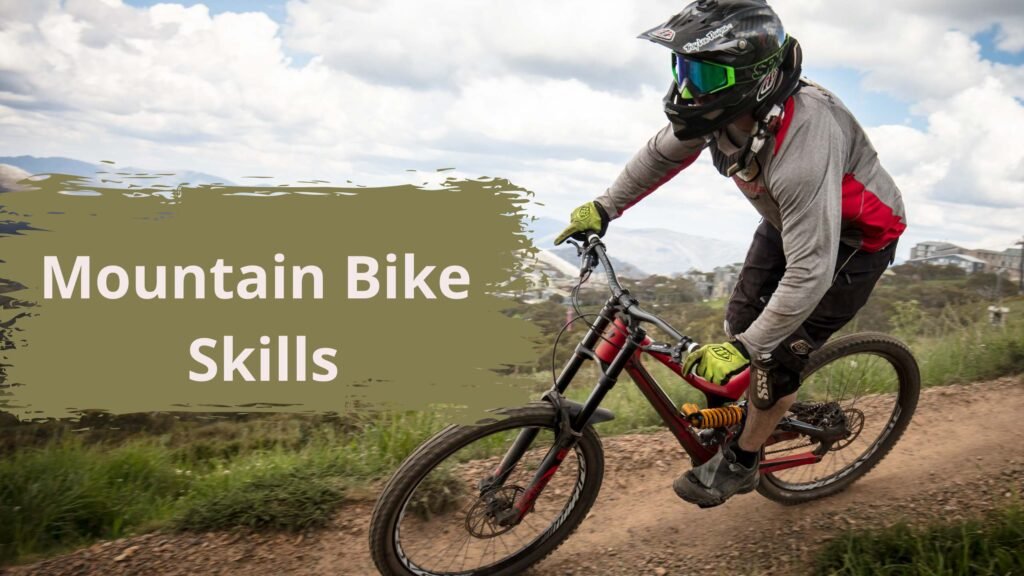I started mountain biking around in 2012. I was a beginner and too excited. That’s why I tried to do stunts with my new bikes and try to ride like a pro, but most times, I fell down and got injured and had bruises on my elbow and shoulders, etc.
Then I realized that I would need skills before I do any stunt or if I want to ride like a pro. Subsequently, I learned all those biking skills.
Therefore, in this article, I will share 12 mountain biking skills for beginners and intermediate riders, which are important to learn in order to become a better mountain biker.
12 Essential Mountain Biking Skills for Beginners and Intermediate Riders

Now, It doesn’t matter if you’re a beginner biker or have a few rides under your belt; these 12 essential mountain biking techniques and skills will definitely help you build confidence, control, and flow on the trails.
Let’s get started:
-
Balance and Body Position
Whether you ride your bike on a simple road, like the regular one, or off-road, like on different types of trails, you will always need proper balance, which is most important for every rider, now be it a beginner or an advanced.
When you are stable on the bike, you are ready to handle any bumps, turns, and drops without tipping over.
How do you master balancing?
Start on ground level: Before you hit any trails in excitement, you first have to start with regular roads or simple trails, especially when you are a beginner.
- You can shift your weight
- Lean slightly forward and backward to feel how it impacts your stability.
- Depending on what suits you better, you can choose to sit like that.
Ready position: You have to keep your elbow bent out and knees slightly bent. While your rear end is hovering over the seat, we call it the attack position.
On descent: When you are riding downhill, you want to ride slowly while bringing your weight back, kind of as you are hovering over the rear wheel. It will distribute your weight properly.
Also check: 4 Weeks Mountain Biking Programs for New Riders (Build skills, stamina & Confidence)
-
Cornering
Many beginner riders brake suddenly when they want to stop their bike or turn on the corner. And I was making this mistake, too, when I was new to mountain biking.
However, I stopped it now because I know it’s not good. If you also do this, then you will feel like you are losing momentum.
Why does cornering matter? It helps you keep your speed without losing control. It’s very important on trails where there are too many twists and turns.
When you corner your bike smoothly, you will feel confident. And you don’t have to completely stop your bike and then start again with more energy.
What to practice
Eyes up: When you are riding a bike, first look through the corner, not your tire. Because the bike naturally follows your line of sight.
Lean your body: Lean your bike, not your body. You want to keep your body in the center. And lean the bike underneath you. It should be like skiing, where you shift the bike, not yourself.
Push down with your outside foot: You can also drop your outside pedal down and press your weight into it to keep your grip the same. It will stabilize you when you take a turn.
Also read: How to develop core strength for biking
-
Braking Control
Many new bikers panic, and they brake as hard as they can, especially on a steep descent, which actually makes things worse. So, instead of braking hard, brake gracefully.
Why biking control is essential? It’s important for a smooth ride and a light all-out wipeout.
How do you break like a pro?
Use both brakes together: Your front brake gives you power to stop, and the back side brake gives you stabilization.
That’s why you wanna squeeze both brakes together. The front one first while feeding the back brake for a smooth stop.
Avoid braking mid-turn: If you brake during the mid-turn, it can cause you to lose balance and slip out.
That’s why you should slow down before you want to turn your bike and then release the brake as you lean into the corner.
If there’s light on the brakes, you wanna get used to applying gentle pressure rather than squeezing hard, as I also mentioned before. It will make you feel more in control.
-
Line Choice
Choosing the right line is important for a smooth ride, avoiding tough obstacles, and keeping your momentum going.
How do you choose a better line?
Read the trail ahead: You want to keep your eyes around 10 to 15 ahead of you. This will give you time to adjust your line based on what obstacle is coming, like a rock, root, or something else.
Practice different lines: Don’t always follow the same line. For example, if there is a rock garden, then you want to look for a smooth line on the side that has fewer obstacles. And you ride there.
Adapt your line to your skill level: If you are not ready for the technical section, then do not feel pressure until you do not build confidence. Most Importantly, don’t forget to follow mountain biking trails etiquettes.
-
Climbing Technique

When you see the height and have to climb it, do not start pedaling out very furiously. It will just consume too much fuel, whether it’s your bike’s if you are using a gas bike or your own body’s energy.
Instead, you should focus on learning mountain bike climbing techniques to conquer a climb without getting completely wiped out.
Why is it important? Proper climbing is important to help you save more energy and keep your bike and you safe.
Right Mountain bike climbing techniques
Stay seated and lean forward: You want to shift your body back forward until it helps your front wheel stay grounded so you won’t have to pop your wheels.
Use lower gears early on: You should not wait until you are mid-climb to shift down. You want to find a comfortable low gear and keep a steady, smooth speed rather than quick pedaling.
Pedal smoothly: You should pedal smoothly as if you are spinning the pedals in a circle, not like you are stomping down. This motion will help you keep your steady rhythm without draining your energy too quickly.
During climbing a hill, you’ll need stamina, so make sure to do some mountain biking exercises to build stamina.
-
Descending with Control
Descending is one of the most thrilling parts of mountain biking. But it’s terrifying for new bikers as it’s too fast and not easy to handle.
However, it requires techniques to stay safe. Once you know that, trust me, it is the most enjoyable part of mountain biking that you will like.
How to handle descents
Get low and shift back: You want to lower your chest and shift your weight towards the rear side of your bike. It will help you stay in balance.
Light up on the brakes: Do not brake hard. Also, do not keep your hand away from the brake. Lightly break whenever you need.
Practice on smaller hills: If the descents make you feel nervous, then I suggest you first try it on from smaller hills.
Once you get comfortable with it and develop some techniques and skills, you can gradually move to giant descending or downhill trails.
Stay relaxed: It’s easy to tense up, but actually, it’s going to make it hard to react to the trail and enjoy your ride. That’s why you want to keep your arms and legs loose so that they can absorb bumps and shift in the terrain correctly.
-
Pedaling Efficiency
Right pedal efficiency is important because it plays an important role in how fast your body will consume fuel and how long you can ride. Here is the right technique:
How to get it right:
Focus on circles, not stomps: Try to imagine as if you are paddling in full circles rather than just pressing it down hard, as I have said before. Keep the power consistent through the pedal stroke; it will make you feel smoother.
Use clipless pedals if you are ready: There are different types of pedals. I suggest you use clipless pedals. They will help you engage your hamstring and calves and give you more power per stroke.
In the beginning, you may feel them a little tricky, but with practice, you will develop a habit.
Confidence is key: Find a steady rhythm around 70-90 rpm is good.
-
Technical Maneuvering
You have to learn technical maneuvering techniques to face rocks, roots, and narrow passages. Here is how to do that.
Tips to navigate the technical section
Slow it down: When your bike is slow and in control, then you can work smarter. You can adjust your balance and line.
Look past obstacles and not directly at them: I have discussed before, too, that you should look 10-15 feet away from your front bike tire. Because wherever you look, your bike follows it. So, don’t directly focus on obstacles.
Shift your head back and lift your front wheel: If the obstacle is large, like logs or rocks, then you want to shift your back and pull up the handlebars to lift the front wheel slightly.
-
Bunny Hopping
I can now do bunny hop, and it took me a some time to learn that. However, I strongly recommend everyone should learn it.
The bunny hop will help you clear any obstacle easily whether it’s a rock, logs, or even small ditches. It’s an intermediate-level and a pro-level skill.
Here’s how you can learn bunny hop step by step:
- You first have to lift your front wheel while pushing down the handlebars
- Then, pull up. While shifting your weight back to the wheel of the ground
- Let the rear wheel lift.
Once you get comfortable with the front wheel, then try to lift the rear wheel too by pushing forward on the bar and scoping your feet upwards. Combine them in a smoother motion.
When you practice regularly, you will start feeling comfortable. Then, you will be able to lift both wheels from the ground together.
For now, start with a small obstacle.
-
Shifting Gears Smoothly
Proper gear-shifting techniques keep your cadence steady, and they also allow you to climb and descend more effectively without the fear of falling.
Besides that, it also reduces strain on your bike and prevents wear and tear.
Shifting Tips
Shift before the climb, not while climbing: I have discussed this before, too. You should anticipate lower gear when you want to start ascending. It will help you keep the momentum.
Don’t cross-chain: You want to avoid using your smallest chainring with your smallest cassette cog (And vice-versa) because it puts unnecessary strain on your drive train.
Practice shifting on the flat ground: You don’t want to jump directly onto the uphill or the downhill.
You first have to learn this gear-shifting technique on simple ground. Once you start confidently shifting gear on a simple ground, then you can move to the next level.
-
Basic Bike Maintenance
Every mountain biker should learn some basic maintenance to keep the mountain bike in top shape. It will save you time; it will save you from getting down on the trails.
Maintenance Tip:
Learn how to change a tire and patch a tube: A flat happens many times when you are riding, especially while off-roading. That’s why you should always carry an extra tube.
Especially when you are riding on long trails; besides this, you can also have a mini pump or CO2 insulator.
Keep your chain clean and lubricated: A clean, lubricated chain will always make shifting smoother. Besides this, You can simply wipe down your chain after every muddy ride.
Check your tire pressure: Low tire pressure is kind of a headache. That’s why you want to check it before every ride, depending on where you want to go.
For off-roading, you can have a little less air in your tire, especially in muddy areas. Otherwise, high pressure is needed, especially on the road.
-
Riding in Different Conditions

Whenever the weather changes, the trail also changes. That’s why you have to learn to ride in different conditions like rain, mud, snow, or loose dirt.
How to adopt different riding conditions?
Lower your tire pressure for mud: I previously discussed that you need to lower your tire pressure slightly when you are going to ride in muddy areas.
Lower tire pressure gives you more grip on wet and loose surfaces. But keep in mind that there shouldn’t be too low pressure on the tire. It can increase the risk of pinch flats.
Avoid braking on wet roads and rocks: Wet roads are slippery. So when you see them, try to keep your speed consistent and avoid sudden braking.
Besides this, you can rule out any small rocks or roots if they are not too big. If they are big, you can use any skill like bunny hopping, as we discussed earlier.
Stay relaxed and go with the flow: You can get a bit uncomfortable seeing different types of conditions where you haven’t ridden before.
So, in that condition, you need to keep yourself relaxed, keep a light grip on the bike, and let the bike move slowly.
Important Things to Remember When Practicing Mountain Biking Skills
Being a new biker who is trying to learn MTB skills, it is important to wear safety mountain bike gear, like a helmet, to protect yourself on the trails.
Because being a new learner, it’s common to fall on the ground, which can cause mountain biking injuries.
Secondly, there are many trails in the United States, but you want to find a local trail near you to practice biking, but make sure it’s beginner-friendly.
How Can I Improve My Mountain Biking Skills?
Improving mountain biking skills is very simple. Here are some tips that you can follow.
Number one, you want to practice a specific skill before; for example, Whenever you go out, make a dedicated time for each skill that you want to learn.
For example, you can make a single day when you will learn bunny hopping, and on that day, you will only learn this skill.
On the other hand, if you want to learn how to break controls, then you will do it the next day, not the day when you are learning bunny hopping.
However, bunny hopping is second; you first have to learn to break properly.
Besides this, If you have good friends who are more experienced than you, then you can try to ride with them.
I personally rode with my friends and uncle, who were older than me and more experienced.
Plus, I also got many tips from some pro bikers whom I knew, and I also watched a lot of mountain bike riders’ videos where they tackled different obstacles. Try different terrains.
If you usually ride on one type of trail, I suggest you switch it up. You can try different types of trails like uphill, downhill, and too many more like muddy, rocky, etc.
You want to practice on mud, rocks, and gravel to help to sharpen your handling skills.
Final Thoughts
Mastering these essential mountain biking skills will take some time, but that’s all part of the fun, so you shouldn’t rush it as soon as you get your new bike.
Besides this, you should practice each of these beginner and intermediate mountain biking skills every day.
When you start developing some basic skills, you’ll notice that each skill complements the others, which will make the learning process easier.
Keep In mind that every pro rider that you see today was once a beginner. If you find yourself frustrated after seeing a pro rider, take a deep breath and remember, they spend a lot of time to reach this level where you see them today. So it’s also going to take time for you to reach this level.
Lastly, the most important mountain biking tips for intermediate bikers are to ride a bike as much as you can, try new skills like bunny hopping and Corning, and keep trying different trails.
Also read: Safety Tips for Mountain Bikers








Everything is very open with a really clear explanation of the challenges.
It was really informative.
Thank you for sharing!